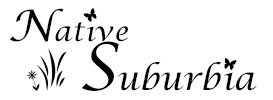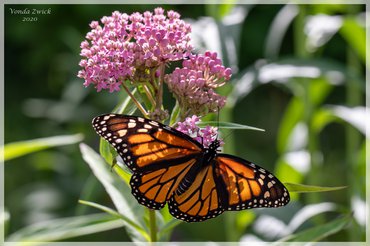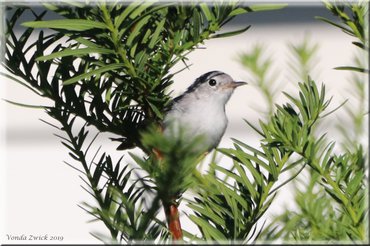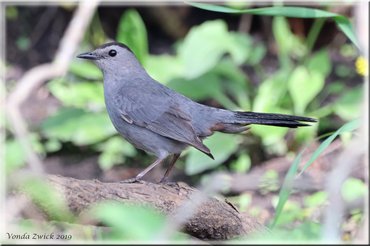About Us
Our Story
The Birds
Perhaps in its early infancy, Native Suburbia started with backyard bird watching. Like many suburbians, we had a variety of bird feeders designed to attract backyard birds. I had a casual interest in photography and I had also been involved in aviculture, working with the conservation of various finch species in captivity.
When I decided to leave aviculture, I shifted my passion for birds to the wild ones in my backyard, and I revisited my very amateurish attempt at wildlife photography. I started thinking about attracting more variety, but aside from providing different forms of bird feeders and food types, I didn't really know much about attracting variety to my yard. In fact, I had no real clue as to the variety that was out there. I knew that we were in the range of many species that I never saw, but I just assumed those species didn't visit the suburbs. If they did, they were in the forest preserves, not my backyard
Enter the Monarch Butterfly
Native Suburbia's true beginnings, however, weren't triggered by the birds, but instead came with the Monarch butterfly. We bought our first milkweed, the host plant for the monarch butterfly, from a local commercial nursery: some swamp milkweed cultivars and some butterflyweed. The first year that we planted them, we welcomed some visiting monarchs to our yard, but no caterpillars. We did not know at the time that the plants had likely been treated with insecticides (why anyone would treat milkweed - a plant bought specifically to feed caterpillars - with a pesticide is beyond me; but unfortunately, it is common practice with commercial nurseries that do not focus on natives).
Despite the lack of caterpillars, the appearance of visiting monarchs was enough to encourage us to buy a monarch butterfly plant kit from the local garden club's native plant sale the following year. While the kit was marketed as a monarch butterfly kit, not every plant included had a direct tie to the monarch butterfly. But they all were a part of the monarch's native habitat, and what we were to discover is that you can't build a bubble to isolate and foster a single species. Nature works by incorporating diversity and predators and prey work together to maintain balance so all species can thrive long-term.
The diversity that came with building a monarch habitat was fascinating. Our yard was filled with such a diversity of life that we were constantly discovering new finds in our own backyard: wonders that we had no idea existed, much less existed in a suburban environment. We have seen a wide array of butterflies, skippers, moths, beetles, bees, flies, crickets, grasshoppers, katydids, and dragonflies. We have more fireflies during the summer than we ever have had before. When neighboring yards are dark, ours is flickering with a natural light show.
Revisiting the Birds
Of course, the more diversity we discovered, the more we wanted to attract. We started to make plant lists based on the insects that use it as a host and the adult insects that feed off its nectar, pollen, or plant juices. And the insect diversity continued to increase.
That is when the story starts to tie back to the birds. When our yard was buzzing with insect life, we finally started to see the diversity in bird species that I could not attract with a birdfeeder. We have had warblers, catbirds, wrens, orioles, and gnatcatchers suddenly visit our yard in search of tasty insect meals. We found something else, too. The birds that visited our feeder, also visited our plants. Goldfinches, house finches, juncos, and sparrows have all been seen feeding on ripe seed heads of plants like coneflower, goldenrod, and New England aster.
That inspired a new wave of plant shopping. Now we started including native plants, bushes, and trees that produced berries, seeds, or nuts to feed the birds and other wildlife. Berries are loved by robins, catbirds, cedar waxwings, orioles, cardinals, and others. Nuts are loved by woodpeckers, nuthatches, and blue jays (and squirrels of course). Leaving plant stalks up all winter fed our seed eaters all throughout the cold months and provided hibernation sites for next year's emerging insects to feed the insectivorous species that will migrate back (or through) in the spring.
Over time, we have found endless discoveries in our backyard just by replacing some little used lawn that offers nothing back to the ecosystem with the plants that were meant to grow here. Seeing what our little backyard gardens could attract, I ventured out to some local park-district managed conservation areas that are walking distance from my house. I was curious to find what additional variety our neighborhood supported with a habitat larger than my little backyard. I was not disappointed.
Organizing Photos and Data
Over time, I have documented these discoveries in pictures, and shared them online on my Facebook page or on Facebook groups. But my discoveries have been largely unorganized. I save pictures by year and then by species, but some pictures have more than one species or include both plants and animals, so I have to decide where best to save them. Does a picture of a Northern Cardinal feeding a cowbird fledgling belong under cardinal or cowbird? Observations are even harder. Trying to find an old post on Facebook is a struggle. There was nothing to tie the story of the picture to the picture itself except my faulty memory.
As a software developer, I knew I wanted to put all of this together in some sort of database. But to do that on my home computer means that it is hard to share with friends and groups. A database-driven website seemed the best way to integrate all of the data into a coherent system of journal posts, galleries, and information, with proper relationships between all elements kept intact. I created this site primarily for myself and to share with friends and acquaintances, but if it reaches beyond that scope and encourages others to give part of their yard back to the ecosystem, that would make me infinitely happy.
Is Going Native All or Nothing?
I will just add that we are not native purists. We have cultivars in our yard. Some are good and are keepers. Some are not so good and likely to be replaced one day. We have nonnatives in the backyard that are staying: fruit trees, lilacs, yews. We plant nonnative annuals from seed because of their pollinator benefits and long bloom times. Our front yard is largely traditional landscaping, although we have started adding natives there as well. We have replaced a lot of lawn in the backyard with native plantings, but we have kept some for recreational use and for the dog. Native Suburbia is not about a hatred for all things nonnative/exotic, but only about a love for giving some space back to the natives. Nonnatives (both plants and wildlife) have worked themselves into our ecosystem over the years and many are here to stay, like it or not. Native Suburbia does not disparage them for surviving where humans have brought them and will discuss them from time to time, noting that they are not native, but present.




